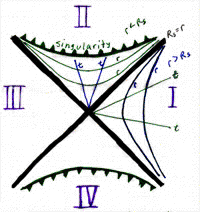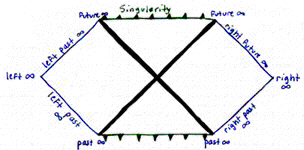




Jillian's Guide to Black Holes: Forming - Types - Outside - Inside - Finding - References - Websites
Penrose Diagrams
Spacetime diagrams are all well and good for standard static black holes. You can fit the event horizon and the singularity in one picture with no problems. However, that is not so with charged and rotating black holes, for there are two event horizons to deal with, as well as the possibility for recrossing those horizons. Roger Penrose developed a different kind of spacetime diagram for dealing with the more complex nature of the charged and rotating black holes.
 |
 |
It would be good to start with something basic, and static black holes are as basic as you can get. Above are two diagrams of an eternal static black hole. To the left is the spacetime diagram. To the right is the Penrose diagram. As you can see, it looks much like the spacetime diagram for a black hole---with one exception. Where the spacetime diagram projects off into infinity, the Penrose diagram ends in clean, neat pointy lines. Hmm! If you look closely at the labels, you'll notice that nothing actually changed except that this diagram is self-contained. No little arrows pointing off into infinity. Instead, we have points and lines that designate the different infinities.
In our universe (the image on the right) there are only five distinct directions: future infinity, right future infinity, right infinity, right past infinity, and past infinity. A worldline from a spacetime diagram might go from the past infinity to the future infinity. Light rays go off into the right future infinity and come from the right past infinity (that whole 45° thing). Only a line of simultaneity could go to the right infinity, which makes sense. With respect to an inertial observer, that line of simultaneity goes on forever. Objects still cross and cannot recross the event horizon and run into the singularity. Objects from one universe can't cross over into another. All is well with this diagram, it follows our rules.


